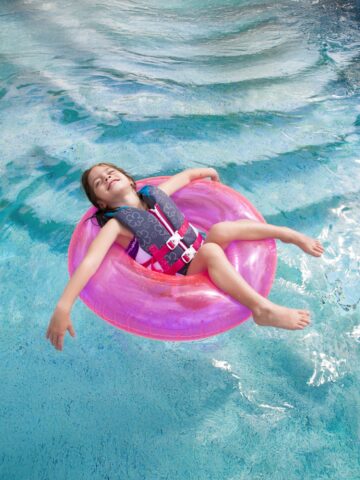By Dr. Georgie Pechulis, pediatric hospitalist at CHOC

This summer our kids will undoubtedly be awaiting their water time with endless excitement, and we as parents will do our best to keep them safe. Amidst our best efforts to educate ourselves and our children on water safety, drowning still tends to peak in these summer months. Secondary drowning is another danger, albeit rare, that parents should be aware of.
What is secondary drowning?
We as pediatricians actually don’t like this term, since it creates a lot of confusion.
Drowning is defined by the International Liaison Committee on Resuscitation as, “a process resulting in primary respiratory impairment from submersion/immersion in a liquid medium.” So what does that mean? Any event from being in water that causes problems breathing, whether it is primary, secondary, wet or dry, or any other forms of drowning.
Secondary or delayed drowning refers to the phenomenon of water inhalation, followed by presumed recovery, and respiratory problems that appear afterwards. Often the story involves being underwater or inhaling water with immediate symptoms that appear to go away. However, vague symptoms persist and cause breathing problems long after the event, to the surprise of parents. It is a subset of drowning and thankfully, is relatively rare.
Secondary Drowning Symptoms and Frequently Asked Questions
My child coughed after accidentally swallowing some water- should I bring him to the ER?
Fortunately, most simple aspiration events are not serious. Parents will need to look for the persistence of symptoms. In other words, you’ll notice your child hasn’t returned to his or her normal breathing or behavior after the incident.
- Breathing: Your child is working hard to breathe by using his belly muscles or if you notice her nostrils flaring or head bobbing. Also, look out for persistent coughing even long after the event, and darkness or blue coloring of the lips.
- Behavior: You notice your child is not acting right. He or she is lethargic, irritable, or not their usual self. This will be different from what you’re normally used to. Use your parental instinct.
My child seemed fine. What happened?
If water irritates the lungs, it can cause inflammation, fluid buildup, and difficulty for the body to receive the oxygen that you breathe. Sometimes these effects happen long after the event has occurred. We expect these symptoms to show within 24 hours after aspiration of water.
If you have any of these concerns, please seek medical attention from your pediatrician or even the Emergency Department if your child appears in distress.
How to prevent secondary drowning
As always, the best way to keep your child safe is to monitor them at all times in the water and to ensure they do not have any access to potential water hazards. This includes not only pools, but filled bathtubs, hot tubs, lakes, koi ponds, and fountains.
- Never leave them unsupervised. For toddlers or any children who are not able to swim, an adult should be within arm’s reach at all times. Never leave the child unattended, even if it is to quickly run in the house and grab something. Commonly, drowning occurs when caregivers briefly leave the child unattended to grab cameras, phones, food or drink, etc. Appoint dedicated and qualified adult supervisors to substitute watch if you need to leave.
- Supervise without distraction. Your job as the supervisor is to do so without distraction. No cell phones, no reading materials, and no distracting conversations. Those brief lapses of attention are when incidents can occur. It’s an important job to supervise your kids in the pool and really key to ensuring your child’s safety.
- Drowning is usually silent. The typical drowning scenario in a movie usually depicts arm flailing, screaming, and water splashing in all directions. The truth is that most drowning occurs without noise. Often the child struggles quietly and slips under the water without a sound. Always be alert and on the watch, for it may not be obvious.
- Be aware of your environment. If you are visiting a family or friend’s home, be aware of any potential water dangers nearby. Homes that do not usually have children often have open access to pools, spas, and natural bodies of water such as ponds and lakes. Children are curious and will want to explore new environments. Be alert.
As a hospital pediatrician and as a mother, often I hear the stories of caregivers shifting their attention to engage in conversation, running in the house to grab something, or other forms of quick distractions that lead to these accidents. If I could ask anything, it’s that we just take time to really focus on protecting our kids by being their undistracted monitor. We want them to enjoy many endless summers of water time to come.
Get more expert health advice delivered to your inbox monthly by subscribing to the KidsHealth newsletter here.
Get more safety and injury prevention tips from CHOC experts
More children are affected by injuries than all other childhood illnesses and diseases combined. Most of these injuries are predictable and preventable. Here’s how to keep your child safe.





